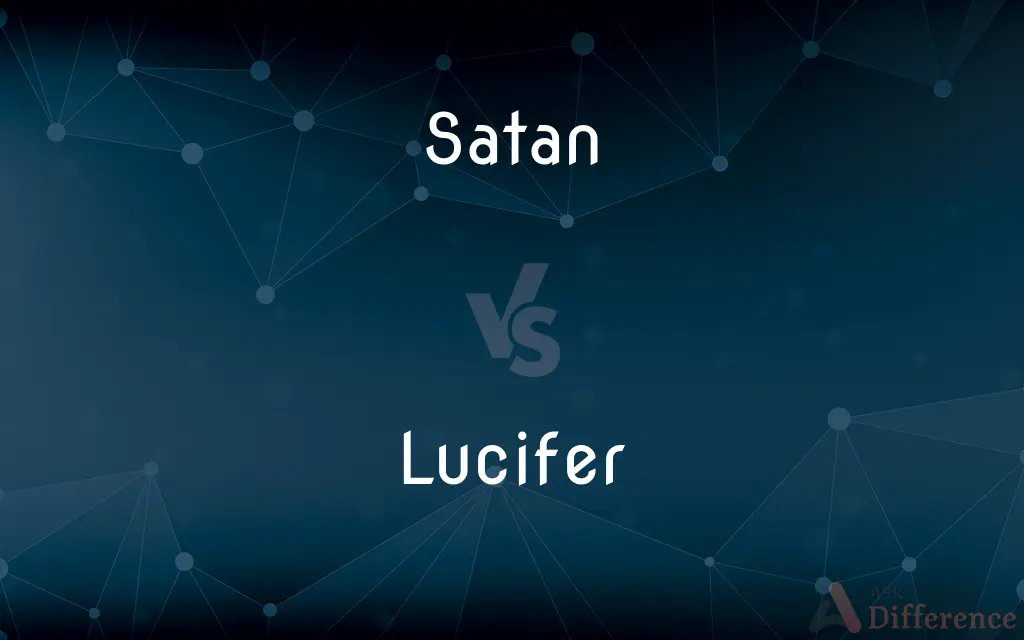Satan vs. Lucifer — What's the Difference?
Edited by Tayyaba Rehman — By Fiza Rafique — Updated on March 15, 2024
Satan is traditionally seen as the embodiment of evil and adversary to good, while Lucifer is often associated with the fallen angel myth, embodying pride and rebellion.

Difference Between Satan and Lucifer
Table of Contents
ADVERTISEMENT
Key Differences
Satan, in many religious texts, is depicted as the ultimate embodiment of evil, temptation, and the adversary of God and mankind. This figure is often associated with the prosecution of human souls, tempting them away from righteousness. Whereas Lucifer, originally a term that meant "light-bringer" or "morning star," is commonly associated with pride and rebellion, often depicted as a beautiful angel who was cast out of heaven for rebelling against God.
In Christian theology, Satan is believed to work against God's purposes, tempting humans to sin and leading them away from divine grace. He is often thought to rule over hell and the demons who reside there. On the other hand, Lucifer's story, particularly as interpreted in literature and some theological traditions, centers on his fall from grace due to his pride and desire to be equal to or greater than God.
The concept of Satan is found in various forms across many religions, not just Christianity but also in Islam (as Shaitan) and Judaism, where he plays different roles but generally embodies opposition to God's will. Lucifer, however, is a figure whose story is primarily rooted in Christian tradition, drawing heavily from interpretations of biblical passages, such as Isaiah 14:12-15, which historically was associated with a Babylonian king but later interpreted by some as referring to Lucifer's fall.
The imagery and symbolism surrounding Satan are often dark and terrifying, evoking fear and caution. He is depicted in various forms, such as a serpent, dragon, or a frightening angelic figure. In contrast, Lucifer's imagery before his fall is usually that of beauty and light, symbolizing his status as a high-ranking angel before his rebellion led to his transformation into a symbol of pride and fall from grace.
The role of Satan in eschatology (the part of theology concerned with death, judgment, and the final destiny of the soul and of humankind) is that of the ultimate antagonist who will be defeated in the final battle between good and evil. Lucifer's role, while significant due to his rebellion, is more about the origin of sin and the pride that leads to downfall, serving as a cautionary tale rather than a central figure in the end times.
ADVERTISEMENT
Comparison Chart
Origin
Embodiment of evil, adversary
Originally a light-bringer, fallen due to pride
Symbolism
Evil, temptation, darkness
Pride, rebellion, fallen beauty
Role in Religion
Adversary of God, tempts humans to sin
Rebelled against God, cast out of heaven
Imagery
Serpent, dragon, dark angelic figure
Beautiful angel, light before fall
Eschatological Role
Ultimate antagonist in final battle
Cautionary tale of pride leading to downfall
Compare with Definitions
Satan
Adversary to God.
In religious texts, Satan challenges the faith of humans and angels alike.
Lucifer
Cautionary tale.
Lucifer's story serves as a warning against the dangers of pride and rebellion against divine order.
Satan
Ruler of hell.
Satan is traditionally seen as presiding over the damned souls in hell.
Lucifer
Fallen angel.
Lucifer was once a high-ranking angel who fell from grace due to his pride.
Satan
Embodiment of evil.
Satan is often depicted tempting humans away from the path of righteousness.
Lucifer
Exemplar of beauty.
Before his fall, Lucifer was described as the epitome of beauty among the angels.
Satan
Symbol of opposition.
Satan represents the opposition to all that is considered morally good and divine.
Lucifer
Bearer of light.
Originally, Lucifer was known as the morning star, symbolizing his role as a bringer of light.
Satan
Tempter of humans.
Satan's role includes leading individuals into temptation and away from divine grace.
Lucifer
Symbol of pride and rebellion.
Lucifer's desire to surpass God led to his ultimate downfall.
Satan
Satan, also known as the Devil, and sometimes also called Lucifer in Christianity, is a non-physical entity in the Abrahamic religions that seduces humans into sin or falsehood. In Judaism, Satan is seen as an agent subservient to God or typically regarded as a metaphor for the yetzer hara, or "evil inclination".
Lucifer
Lucifer is the name of various figures in folklore associated with the planet Venus. Originally stemming from a son of the personified dawn, the goddess Aurora, in Roman mythology, the entity's name was subsequently absorbed into Christian folklore as a name for Satan.
Satan
In Abrahamic religions, a powerful spiritual being, the tempter and persecutor of humanity, sometimes considered as an angel who rebelled against God and became the Devil.
Lucifer
(Bible) An angelic being who was cast from heaven as punishment for his rebellious pride. Lucifer is traditionally identified with Satan.
Satan
Alternative form of Satan.
Lucifer
The planet Venus in its appearance as the morning star. Also called Phosphorus.
Satan
The grand adversary of man; the Devil, or Prince of darkness; the chief of the fallen angels; the archfiend.
I beheld Satan as lightning fall from heaven.
Lucifer
Lucifer A friction match.
Satan
(Judeo-Christian and Islamic religions) chief spirit of evil and adversary of God; tempter of mankind; master of Hell
Lucifer
A self-igniting match, ie. one which could be lit by striking on any surface (as opposed to safety matches which only light against the material on the side of the box).
Lucifer
The planet Venus, when appearing as the morning star; - applied in Isaiah by a metaphor to a king of Babylon.
How art thou fallen from heaven, O Lucifer, son of the morning! how art thou cut down to the ground which didst weaken the nations!
Tertullian and Gregory the Great understood this passage of Isaiah in reference to the fall of Satan; in consequence of which the name Lucifer has since been applied to Satan.
Lucifer
Hence, Satan.
How wretchedIs that poor man that hangs on princes' favors! . . . When he falls, he falls like Lucifer,Never to hope again.
Lucifer
A match{1} made of a sliver of wood tipped with a combustible substance, and ignited by friction; - called also lucifer match, and locofoco, now most commonly referred to as a friction match. See Locofoco.
Lucifer
A genus of free-swimming macruran Crustacea, having a slender body and long appendages.
Lucifer
(Judeo-Christian and Islamic religions) chief spirit of evil and adversary of God; tempter of mankind; master of Hell
Lucifer
Lighter consisting of a thin piece of wood or cardboard tipped with combustible chemical; ignites with friction;
He always carries matches to light his pipe
Common Curiosities
What does Lucifer mean?
Lucifer means "light-bringer" or "morning star," originally denoting a high-ranking angelic status.
What led to Lucifer's fall?
Lucifer's fall was due to his pride and desire to be above God, leading to his expulsion from heaven.
What roles do Satan and Lucifer play in Christianity?
Satan is the tempter and enemy of humanity, whereas Lucifer's role highlights the consequences of pride and rebellion against God.
Can Lucifer be redeemed?
Within most traditional theological views, Lucifer's fall is permanent, symbolizing irrevocable pride and rebellion.
How is Satan depicted in religious texts?
Satan is depicted as the ultimate tempter, adversary to God, and the embodiment of evil.
Are Satan and Lucifer the same entity?
While often used interchangeably, they originate from different contexts; Satan as the adversary and embodiment of evil, and Lucifer as a specific fallen angel associated with pride.
Do Satan and Lucifer have power over humans?
They are depicted as having the ability to tempt or influence humans, but not to overpower human free will.
What lesson can be learned from Lucifer's fall?
Lucifer's fall serves as a cautionary tale against the dangers of pride and the importance of humility before divine authority.
Is Satan's role the same in all religions?
Satan's role varies across religious traditions but generally embodies opposition to divine will and the temptation of humans.
What is the significance of Lucifer's beauty?
His beauty symbolizes his high status and the tragedy of his fall, emphasizing the loss and consequences of pride.
How do depictions of Satan and Lucifer differ in art and literature?
Satan is often depicted in dark, fearsome imagery, while Lucifer is initially portrayed with beauty and light, reflecting their respective symbolisms.
What is the eschatological significance of Satan?
Satan is seen as the principal antagonist in the final battle between good and evil, destined to be defeated.
Are there any cultures that view Satan or Lucifer positively?
Some modern interpretations and cultural depictions challenge traditional views, presenting them as symbols of freedom or rebellion against tyranny.
How do Satan and Lucifer influence human behavior, according to religious beliefs?
They are seen as influencers tempting or encouraging humans to stray from moral paths, though humans retain free will.
Why are Satan and Lucifer important figures in religious studies?
They embody complex theological and moral concepts, such as the nature of evil, free will, pride, and the consequences of rebellion against divine order.
Share Your Discovery

Previous Comparison
Mass vs. Volume
Next Comparison
Inner vs. OuterAuthor Spotlight
Written by
Fiza RafiqueFiza Rafique is a skilled content writer at AskDifference.com, where she meticulously refines and enhances written pieces. Drawing from her vast editorial expertise, Fiza ensures clarity, accuracy, and precision in every article. Passionate about language, she continually seeks to elevate the quality of content for readers worldwide.
Edited by
Tayyaba RehmanTayyaba Rehman is a distinguished writer, currently serving as a primary contributor to askdifference.com. As a researcher in semantics and etymology, Tayyaba's passion for the complexity of languages and their distinctions has found a perfect home on the platform. Tayyaba delves into the intricacies of language, distinguishing between commonly confused words and phrases, thereby providing clarity for readers worldwide.
















































